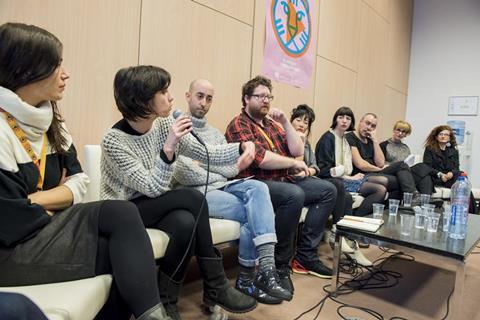At a panel in Rotterdam, the ‘next wave’ of festival programmers from across the globe debated topics such as how much to programme audience-friendly films while championing more challenging work.

As Thure Munkholm from Copenhagen’s CPH:PIX asked succinctly: “How do we get the audience to take a chance with us to screen what is new? That is getting harder and harder.”
He said it’s important to develop with an audience, not just impose a festivals ideas on them. “There is an actual audience that we want to evolve with. In order to push the boundaries, you have to communicate with the audience. “
Michelle Carey of the Melbourne Film Festival said: “I don’t believe in looking down on the audience and pandering down to the lowest common denominator.”
She paid tribute to IFFR for programming medium-length films, something that’s hard for more traditional festivals to find homes for. “If you ask my programming team, it’s the bane of their existence, how to programme different formats,” she added.
London: audiences drawn to themes
Kate Taylor from the BFI London Film Festival said that London had found audiences were attracted to moods and themes, especially when taking a chance on a newer filmmaker.
“One of the challenges is thinking about how do we keep having audiences for new and emerging voices, especially when there are so many films being released,” Taylor said.
“In London, we did research around what makes an audience member come to see films. We found a lot of people said ‘what the film was about’ and ‘genre,’ lower down their lists were things like stars and critical response.
“The way that London has worked is creating thematic strands, like Love, Laugh, Dare, Thrill and Journey. It’s not about saying, ‘This is what the film is’. It’s about identifying some of the pleasure of that film. And it seems like It’s working, audiences are taking chances on films they might not otherwise find.”
Mexico: two-sided approach
Eva Sangiorgi of Ficunam in Mexico, added that there are very much “two sides to what we do”.
She said: “The main aim is to get the public and create a new audience, we want a really young audience. But also there is a curatorial interest for us…
“We think of the films we want to share with cinephiles and other curators, and then I struggle a lot with my programmers, because I also have to understand the audience has to have an entrance to see something very demanding.
“We try to do programmes all during the year. We work in critical exercises with students. We are still in a process of doing it better.”
Lisbon: cinephile approach
Cintia Gil of Portugal’s DocLisboa takes a more purely cinephile approach with programming choices.
“If we don’t programme a film because of the audience, that’s a very bad sign,” she said.
“Every film has its audience, so it’s about building contexts and dialogues between the films. It’s lazy to leave a film that we like very much or we think it’s important because of that reason [the audience].”
That means a year-round dialogue with the audience in Lisbon.
“We do interviews, debates, roundtables, so we try to get into a situation where the audience feels like they belong to this, or they can dialogue with it or even fight with it,” added Gilm.
“I believe each film finds its audience. I don’t think a film festival’s mission is not to have full cinemas every session.”
Jerusalem: youthful ambition
In Jerusalem, Elad Samorzik is trying to interest more youth audiences.
“The age of our audience is relatively high, so we are trying to get younger audiences to the Cinematheque and the festival,” said Samorzik.
“We’ve added sections that are targeted at a younger audience, like a midnight section or a competition for children’s films, judged by children.”
He also pointed to more simple tactics like advertising at universities, and making sure catalogue descriptions of the films are enticing to audiences.
IFFR: partnerships remain key
At Rotterdam itself, famed for its big and loyal audiences, Inge de Leeuw said that working with partners is key.
“We are actively looking for partnerships with organisations who have a big, young audience,” said the programmer.
“For example a radio station that can promote it through their channels. Last year we did a Ping Pong Summer event with Vice, so the audience was Vice-y. So that really works. And also we work with schools.”
Having clear programming strands also helps audiences know what they might like, whether that’s Rotterdam’s more mainstream Limelight or new voices Bright Future strands.
“If you create distinctive sections and keep them long-term, the audience will trust those sections,” Jerusalem’s Samorzik added.
John Canciani of the Winterthur International Short Film Festival in Switzerland, said it’s even fine sometimes to not please the audience.
“Its okay to hate some films, you can push the boundaries. But people come to a festival to see things they won’t see on television,” he said.
World premieres issue
The hot button issue of festivals competing for world premieres also came up.
Samorzik said for Jerusalem it is less important. “I’m not wasting my energy fighting with other festivals for premieres,” he stated.
DocLisboa’s Gil added that the competition can create a toxic environment. “I don’t agree with festivals that have this dogma about world premieres. It’s violent,” she said.
IFFR’s de Leeuw noted that, for Rotterdam, landing a film “is not just about premieres - it’s about where sales agents think they can sell their films. I’m prepared to fight for those that I really like.”

























No comments yet